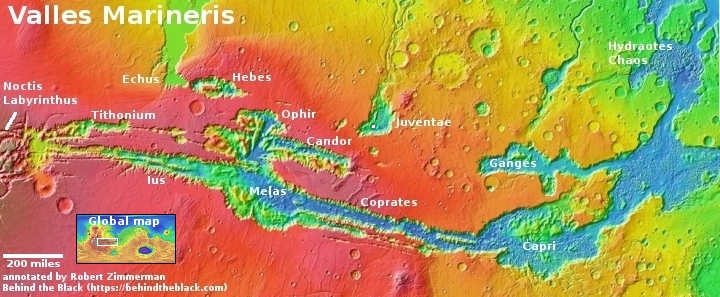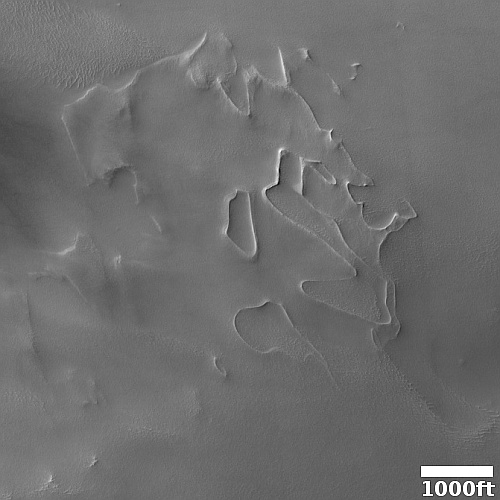Buried ridges at the bottom of a Martian abyss
Today’s cool image could be labeled a “What the heck?!” photo, as the origin of its most distinct feature is utterly baffling. The picture to the right, cropped, reduced, and sharpened to post here, was taken on June 18, 2023 by the high resolution camera on Mars Reconnaissance Orbiter (MRO), and shows what look like a collection of meandering ridges peeking out from a terrain covered by thick dust.
The scientists label this dust-covered ground, as well as the ripple dunes to the south in the full image, “sand sheets.” Without question, the ground here seems to resemble a Sahara-like terrain. It is utterly featureless, other than the few bedrock features that poke up out of that sand. In the full image some peaks stick out, but it the meandering ridges in this section that are most intriguing. They are reminiscent of rimstone dams in caves, but what formed them remains baffling, since cave rimstone dams are formed by the interaction of limestone and water, and there is absolutely no evidence of any near surface ice at this location in the dry equatorial regions of Mars.
All the ridges signify is a buried terrain formed in some inexplicable way.

On the overview map above the white dot near the center and inside the chasm dubbed Juventae marks this location. Juventae Chasma is deep, with walls that rise up 20,000 to 25,000 feet. Any dust that gets blown into it would get trapped there, since the thin Martian atmosphere would not be able to lift it back out. Thus it is not surprising that there is complex bedrock buried deeply under that sand.
Juventae also once again gives us a sense of scale. Though it is dwarfed by the giant Valles Marineris canyon to the south, its depth, three to five times deeper than the Grand Canyon, would make the widest and deepest part of that natural wonder of Earth appear to be no more than a small crack in the ground. If you stood on Juventae’s south rim, you would be able to look directly downward 20,000 feet at this point below. On Earth the only places where such a view is generally available is on the peaks of mountains. On Mars that view is available for more than 100 miles along Juventae’s south rim.
On Christmas Eve 1968 three Americans became the first humans to visit another world. What they did to celebrate was unexpected and profound, and will be remembered throughout all human history. Genesis: the Story of Apollo 8, Robert Zimmerman's classic history of humanity's first journey to another world, tells that story, and it is now available as both an ebook and an audiobook, both with a foreword by Valerie Anders and a new introduction by Robert Zimmerman.
The print edition can be purchased at Amazon or from any other book seller. If you want an autographed copy the price is $60 for the hardback and $45 for the paperback, plus $8 shipping for each. Go here for purchasing details. The ebook is available everywhere for $5.99 (before discount) at amazon, or direct from my ebook publisher, ebookit. If you buy it from ebookit you don't support the big tech companies and the author gets a bigger cut much sooner.
The audiobook is also available at all these vendors, and is also free with a 30-day trial membership to Audible.
"Not simply about one mission, [Genesis] is also the history of America's quest for the moon... Zimmerman has done a masterful job of tying disparate events together into a solid account of one of America's greatest human triumphs."--San Antonio Express-News
Today’s cool image could be labeled a “What the heck?!” photo, as the origin of its most distinct feature is utterly baffling. The picture to the right, cropped, reduced, and sharpened to post here, was taken on June 18, 2023 by the high resolution camera on Mars Reconnaissance Orbiter (MRO), and shows what look like a collection of meandering ridges peeking out from a terrain covered by thick dust.
The scientists label this dust-covered ground, as well as the ripple dunes to the south in the full image, “sand sheets.” Without question, the ground here seems to resemble a Sahara-like terrain. It is utterly featureless, other than the few bedrock features that poke up out of that sand. In the full image some peaks stick out, but it the meandering ridges in this section that are most intriguing. They are reminiscent of rimstone dams in caves, but what formed them remains baffling, since cave rimstone dams are formed by the interaction of limestone and water, and there is absolutely no evidence of any near surface ice at this location in the dry equatorial regions of Mars.
All the ridges signify is a buried terrain formed in some inexplicable way.

On the overview map above the white dot near the center and inside the chasm dubbed Juventae marks this location. Juventae Chasma is deep, with walls that rise up 20,000 to 25,000 feet. Any dust that gets blown into it would get trapped there, since the thin Martian atmosphere would not be able to lift it back out. Thus it is not surprising that there is complex bedrock buried deeply under that sand.
Juventae also once again gives us a sense of scale. Though it is dwarfed by the giant Valles Marineris canyon to the south, its depth, three to five times deeper than the Grand Canyon, would make the widest and deepest part of that natural wonder of Earth appear to be no more than a small crack in the ground. If you stood on Juventae’s south rim, you would be able to look directly downward 20,000 feet at this point below. On Earth the only places where such a view is generally available is on the peaks of mountains. On Mars that view is available for more than 100 miles along Juventae’s south rim.
On Christmas Eve 1968 three Americans became the first humans to visit another world. What they did to celebrate was unexpected and profound, and will be remembered throughout all human history. Genesis: the Story of Apollo 8, Robert Zimmerman's classic history of humanity's first journey to another world, tells that story, and it is now available as both an ebook and an audiobook, both with a foreword by Valerie Anders and a new introduction by Robert Zimmerman.
The print edition can be purchased at Amazon or from any other book seller. If you want an autographed copy the price is $60 for the hardback and $45 for the paperback, plus $8 shipping for each. Go here for purchasing details. The ebook is available everywhere for $5.99 (before discount) at amazon, or direct from my ebook publisher, ebookit. If you buy it from ebookit you don't support the big tech companies and the author gets a bigger cut much sooner.
The audiobook is also available at all these vendors, and is also free with a 30-day trial membership to Audible.
"Not simply about one mission, [Genesis] is also the history of America's quest for the moon... Zimmerman has done a masterful job of tying disparate events together into a solid account of one of America's greatest human triumphs."--San Antonio Express-News



In the old days, that cropped photo would have provided months of fun Richard Hoagland interviews with Art Bell.
Mars is infinitely more interesting than the Moon.
Just send thousands of rovers, flying objects, sample retrieving devices to Mars.
The dark area at the top of the original picture is full of dust devil trails… More proof that dark spots generate the little devils.
In the expanded photo, see the near-perfectly-circular elevated “mesa” in the center-left of the upper part. Striking.